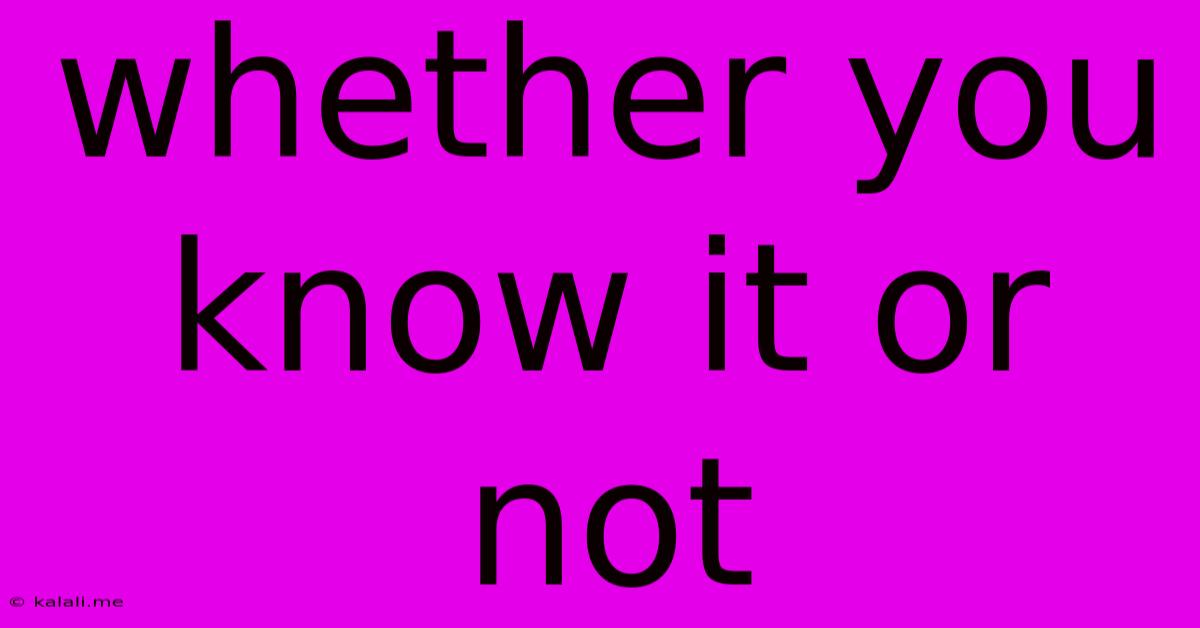Whether You Know It Or Not
Kalali
May 24, 2025 · 3 min read

Table of Contents
Whether You Know It or Not: The Hidden Influences Shaping Your Decisions
We make hundreds of decisions every day, from seemingly trivial choices like what to eat for breakfast to significant ones impacting our careers and relationships. But how much control do we really have? This article explores the fascinating world of unconscious biases and subtle influences that shape our choices, whether we're aware of them or not. Understanding these forces can empower us to make more informed and intentional decisions.
The Illusion of Conscious Choice
We like to think we're rational beings, carefully weighing options before making a decision. However, research in cognitive psychology reveals a different picture. Much of our decision-making process happens unconsciously, driven by ingrained biases, heuristics (mental shortcuts), and environmental cues. This isn't to say we're entirely puppets to our subconscious; rather, it highlights the significant role of unconscious processes in shaping our choices.
Unconscious Biases: The Silent Architects of Decision-Making
Unconscious biases are deeply ingrained attitudes or stereotypes that affect our understanding, actions, and decisions in an unconscious manner. These biases can stem from various sources, including cultural norms, personal experiences, and even the media we consume. Examples include:
- Confirmation bias: The tendency to favor information confirming existing beliefs and ignore contradictory evidence.
- Anchoring bias: Over-relying on the first piece of information received (the "anchor") when making subsequent judgments.
- Availability heuristic: Overestimating the likelihood of events that are easily recalled, often due to their vividness or recent occurrence.
- Halo effect: Letting one positive trait influence overall perception, overlooking other aspects.
These biases can lead to unfair or inaccurate judgments, impacting everything from hiring decisions to interpersonal relationships. Becoming aware of these biases is the first step towards mitigating their influence.
Environmental Cues: The Subtle Push and Pull
Our environment plays a surprisingly powerful role in shaping our choices, often without our conscious awareness. Consider these examples:
- Nudging: Subtle changes in the environment designed to influence behavior. For example, strategically placing healthy food options at eye level in a cafeteria can increase their consumption.
- Framing effects: The way information is presented can significantly alter our perception and choices. For instance, a product advertised as "90% fat-free" is often perceived more favorably than one described as "10% fat."
- Social proof: The tendency to follow the actions of others, particularly when uncertain. This explains the effectiveness of testimonials and social media endorsements.
Understanding how these environmental cues operate allows us to create environments that promote desirable behaviors and choices, both for ourselves and others.
Taking Control: Strategies for Conscious Decision-Making
While unconscious influences are powerful, we aren't powerless. Here are some strategies to enhance conscious decision-making:
- Mindfulness: Practicing mindfulness helps increase awareness of our thoughts and feelings, allowing us to identify and challenge biases.
- Seeking diverse perspectives: Actively seeking out viewpoints that differ from our own can counteract confirmation bias.
- Delaying gratification: Taking time to reflect before making important decisions reduces the influence of impulsive choices driven by immediate emotions.
- Critical thinking: Developing strong critical thinking skills allows us to evaluate information objectively and identify fallacies in reasoning.
Ultimately, recognizing that our choices are shaped by forces beyond our immediate awareness is a crucial step towards making more intentional and informed decisions. By understanding the power of unconscious biases and environmental cues, we can strive for greater self-awareness and ultimately, greater control over our lives. Whether you know it or not, these influences are at play – and understanding them is the key to navigating them effectively.
Latest Posts
Latest Posts
-
How To Repair A Seized Engine
May 25, 2025
-
5 4 Triton Serpentine Belt Diagram With Ac
May 25, 2025
-
How To Separate Fan And Light Switch
May 25, 2025
-
Fallen Angels Names In The Bible
May 25, 2025
-
At The Bottom Or On The Bottom
May 25, 2025
Related Post
Thank you for visiting our website which covers about Whether You Know It Or Not . We hope the information provided has been useful to you. Feel free to contact us if you have any questions or need further assistance. See you next time and don't miss to bookmark.